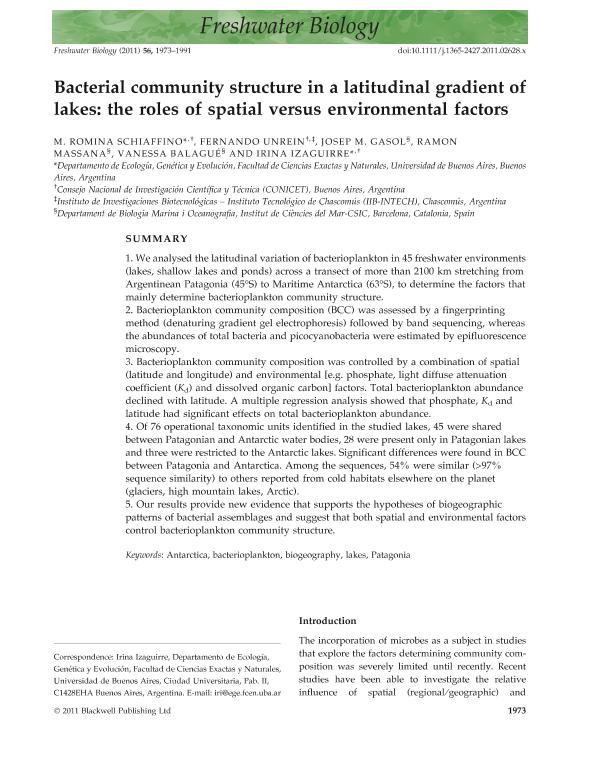Mostrar el registro sencillo del ítem
dc.contributor.author
Schiaffino, María Romina

dc.contributor.author
Unrein, Fernando

dc.contributor.author
Gasol, Josep M.

dc.contributor.author
Massana, Ramon
dc.contributor.author
Balagué, Vanessa
dc.contributor.author
Izaguirre, Irina

dc.date.available
2020-01-27T20:24:41Z
dc.date.issued
2011-10
dc.identifier.citation
Schiaffino, María Romina; Unrein, Fernando; Gasol, Josep M.; Massana, Ramon; Balagué, Vanessa; et al.; Bacterial community structure in a latitudinal gradient of lakes: The roles of spatial versus environmental factors; Wiley Blackwell Publishing, Inc; Freshwater Biology (print); 56; 10; 10-2011; 1973-1991
dc.identifier.issn
0046-5070
dc.identifier.uri
http://hdl.handle.net/11336/95897
dc.description.abstract
1.We analysed the latitudinal variation of bacterioplankton in 45 freshwater environments (lakes, shallow lakes and ponds) across a transect of more than 2100km stretching from Argentinean Patagonia (45°S) to Maritime Antarctica (63°S), to determine the factors that mainly determine bacterioplankton community structure. 2.Bacterioplankton community composition (BCC) was assessed by a fingerprinting method (denaturing gradient gel electrophoresis) followed by band sequencing, whereas the abundances of total bacteria and picocyanobacteria were estimated by epifluorescence microscopy. 3.Bacterioplankton community composition was controlled by a combination of spatial (latitude and longitude) and environmental [e.g. phosphate, light diffuse attenuation coefficient (Kd) and dissolved organic carbon] factors. Total bacterioplankton abundance declined with latitude. A multiple regression analysis showed that phosphate, Kd and latitude had significant effects on total bacterioplankton abundance. 4.Of 76 operational taxonomic units identified in the studied lakes, 45 were shared between Patagonian and Antarctic water bodies, 28 were present only in Patagonian lakes and three were restricted to the Antarctic lakes. Significant differences were found in BCC between Patagonia and Antarctica. Among the sequences, 54% were similar (>97% sequence similarity) to others reported from cold habitats elsewhere on the planet (glaciers, high mountain lakes, Arctic). 5.Our results provide new evidence that supports the hypotheses of biogeographic patterns of bacterial assemblages and suggest that both spatial and environmental factors control bacterioplankton community structure.
dc.format
application/pdf
dc.language.iso
eng
dc.publisher
Wiley Blackwell Publishing, Inc

dc.rights
info:eu-repo/semantics/openAccess
dc.rights.uri
https://creativecommons.org/licenses/by-nc-sa/2.5/ar/
dc.subject
ANTARCTICA
dc.subject
BACTERIOPLANKTON
dc.subject
BIOGEOGRAPHY
dc.subject
LAKES
dc.subject
PATAGONIA
dc.subject.classification
Ecología

dc.subject.classification
Ciencias Biológicas

dc.subject.classification
CIENCIAS NATURALES Y EXACTAS

dc.title
Bacterial community structure in a latitudinal gradient of lakes: The roles of spatial versus environmental factors
dc.type
info:eu-repo/semantics/article
dc.type
info:ar-repo/semantics/artículo
dc.type
info:eu-repo/semantics/publishedVersion
dc.date.updated
2020-01-15T19:56:57Z
dc.journal.volume
56
dc.journal.number
10
dc.journal.pagination
1973-1991
dc.journal.pais
Reino Unido

dc.journal.ciudad
Londres
dc.description.fil
Fil: Schiaffino, María Romina. Universidad de Buenos Aires. Facultad de Ciencias Exactas y Naturales. Departamento de Ecología, Genética y Evolución. Laboratorio de Limnología; Argentina. Consejo Nacional de Investigaciones Científicas y Técnicas. Oficina de Coordinación Administrativa Ciudad Universitaria. Instituto de Ecología, Genética y Evolución de Buenos Aires. Universidad de Buenos Aires. Facultad de Ciencias Exactas y Naturales. Instituto de Ecología, Genética y Evolución de Buenos Aires; Argentina
dc.description.fil
Fil: Unrein, Fernando. Consejo Nacional de Investigaciones Científicas y Técnicas. Centro Científico Tecnológico Conicet - La Plata. Instituto de Investigaciones Biotecnológicas. Instituto de Investigaciones Biotecnológicas "Dr. Raúl Alfonsín" (sede Chascomús). Universidad Nacional de San Martín. Instituto de Investigaciones Biotecnológicas. Instituto de Investigaciones Biotecnológicas "Dr. Raúl Alfonsín" (sede Chascomús); Argentina
dc.description.fil
Fil: Gasol, Josep M.. Consejo Superior de Investigaciones Científicas. Instituto de Ciencias del Mar; España
dc.description.fil
Fil: Massana, Ramon. Consejo Superior de Investigaciones Científicas. Instituto de Ciencias del Mar; España
dc.description.fil
Fil: Balagué, Vanessa. Consejo Superior de Investigaciones Científicas. Instituto de Ciencias del Mar; España
dc.description.fil
Fil: Izaguirre, Irina. Universidad de Buenos Aires. Facultad de Ciencias Exactas y Naturales. Departamento de Ecología, Genética y Evolución. Laboratorio de Limnología; Argentina. Consejo Nacional de Investigaciones Científicas y Técnicas. Oficina de Coordinación Administrativa Ciudad Universitaria. Instituto de Ecología, Genética y Evolución de Buenos Aires. Universidad de Buenos Aires. Facultad de Ciencias Exactas y Naturales. Instituto de Ecología, Genética y Evolución de Buenos Aires; Argentina
dc.journal.title
Freshwater Biology (print)

dc.relation.alternativeid
info:eu-repo/semantics/altIdentifier/url/https://onlinelibrary.wiley.com/doi/abs/10.1111/j.1365-2427.2011.02628.x
dc.relation.alternativeid
info:eu-repo/semantics/altIdentifier/doi/http://dx.doi.org/10.1111/j.1365-2427.2011.02628.x
Archivos asociados
